AWS Step Functions is a visual workflow service that allows you to orchestrate AWS services, automate business processes, and build serverless applications. Step Functions workflows manage failures, retries, parallelization, service integrations, and observability to help developers focus on higher-value business logic. This article will cover how to manage AWS Step Functions workflows (state machines) using the Boto3 library (Python SDK for AWS).
Table of contents
If you’re new to the Boto3 library, we encourage you to check out the Introduction to Boto3 library article.
What is Step Functions
AWS Step Functions is an orchestration service that allows you to use AWS Lambda functions and other AWS services to build and automate business-critical workflows. It allows you to describe your processes as a series of event-driven steps, each powered by AWS Lambda or other supported AWS services and responsible for its part of the process. Every workflow is described in JSON-like syntax.
We’ve recently covered Step Functions in the following articles:
In addition to those articles, we strongly recommend you to watch the “Building Business Workflows with AWS Step Functions” re:Invent video:
Getting started with Boto3 Step Functions
As an example, let’s create a workflow that consists of two Lambda functions and uses the Choice state.
Demo State Machine
- ProcessTransaction – is the
Choicestate that uses theTransactionTypeinput value to choose the next step (process purchase or process refund) - ProcessPurchase – is the
Taskimplemented by the Lambda function - ProcessRefund – is the
Taskimplemented by the Lambda function
Here’s the workflow visualization:
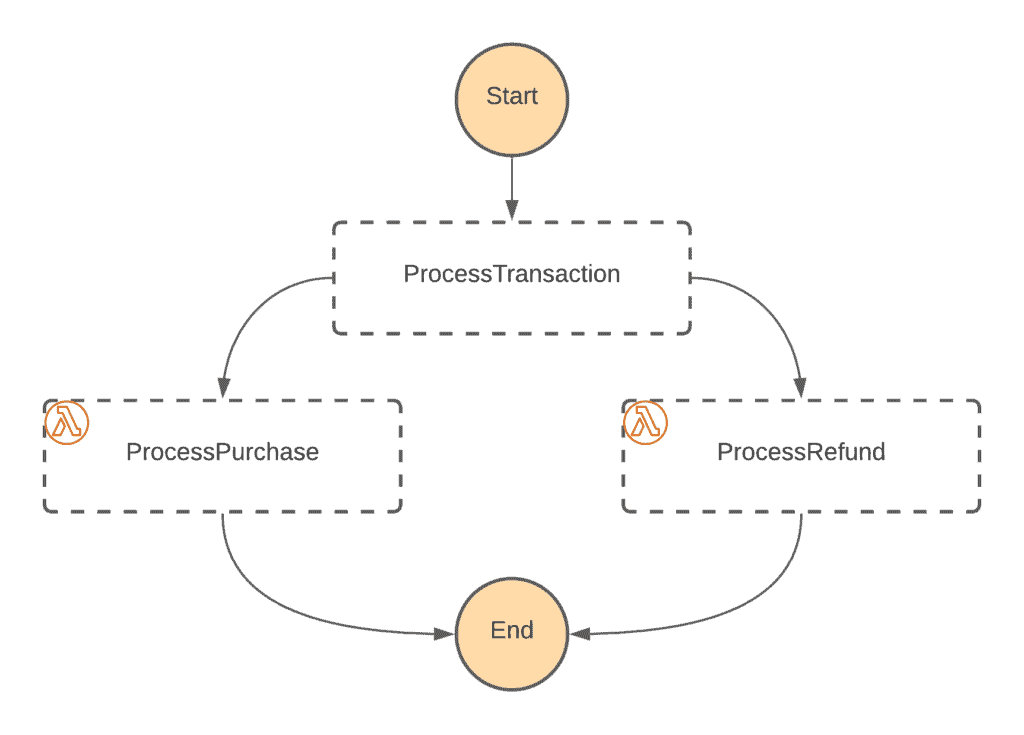
Here’s the workflow definition:
{
'Comment': 'Transaction Processor State Machine',
'StartAt': 'ProcessTransaction',
'States': {
'ProcessTransaction': {
'Type': 'Choice',
'Choices': [
{
'Variable': '$.TransactionType',
'StringEquals': 'PURCHASE',
'Next': 'ProcessPurchase'
},
{
'Variable': '$.TransactionType',
'StringEquals': 'REFUND',
'Next': 'ProcessRefund'
}
]
},
'ProcessPurchase': {
'Type': 'Task',
'Resource': process_purchase_arn,
'End': True
},
'ProcessRefund': {
'Type': 'Task',
'Resource': process_refund_arn,
'End': True
}
}
}Create Step Functions workflow
To create the Step Functions workflows, you must use the create_state_machine() method for the Boto3 SFN client.
We first create two Lambda functions for our State Machine for our demo.
For more information on working with AWS Lambda using Boto3, please look at our Working with AWS Lambda in Python using the Boto3 article.
Process purchase Lambda
This is the demo Lambda function that is supposed to process a purchase:
def lambda_handler(event, context):
print('event:', event)
response = {
'TransactionType': event['TransactionType'],
'Message': 'From Process Purchase',
}
return responseProcess refund Lambda
This is the demo Lambda function that is supposed to process a refund:
def lambda_handler(event, context):
print('event:', event)
response = {
'TransactionType': event['TransactionType'],
'Message': 'From Process Refund',
}
return responseNow, we need to zip our functions and upload them to the AWS using Boto3:

To create a Lambda function zip archive from Python code, you need to use the shutil.make_archive() method.
import shutil
shutil.make_archive(output_filename, 'zip', dir_name)Deploying Lambda functions
Next, we must define a Lambda function IAM role with the Lambda execution permissions.
For simplicity, we’ll use AWS managedLambdaBasicExecution role.
For more information on working with IAM in Python using Boto3, check out our Working with IAM in Python using the Boto3 article.
import boto3
iam_client = boto3.client('iam')
lambda_client = boto3.client('lambda')
with open('process_purchase.zip', 'rb') as f:
process_purchase_zip = f.read()
with open('process_refund.zip', 'rb') as f:
process_refund_zip = f.read()
role = iam_client.get_role(RoleName='LambdaBasicExecution')
process_purchase_response = lambda_client.create_function(
FunctionName='process_purchase',
Runtime='python3.9',
Role=role['Role']['Arn'],
Handler='process_purchase.lambda_handler',
Code=dict(ZipFile=process_purchase_zip),
Timeout=300, # Maximum allowable timeout
)
process_refund_response = lambda_client.create_function(
FunctionName='process_refund',
Runtime='python3.9',
Role=role['Role']['Arn'],
Handler='process_refund.lambda_handler',
Code=dict(ZipFile=process_refund_zip),
Timeout=300, # Maximum allowable timeout
)
print(process_purchase_response)
print(process_refund_response)Here’s an execution output:
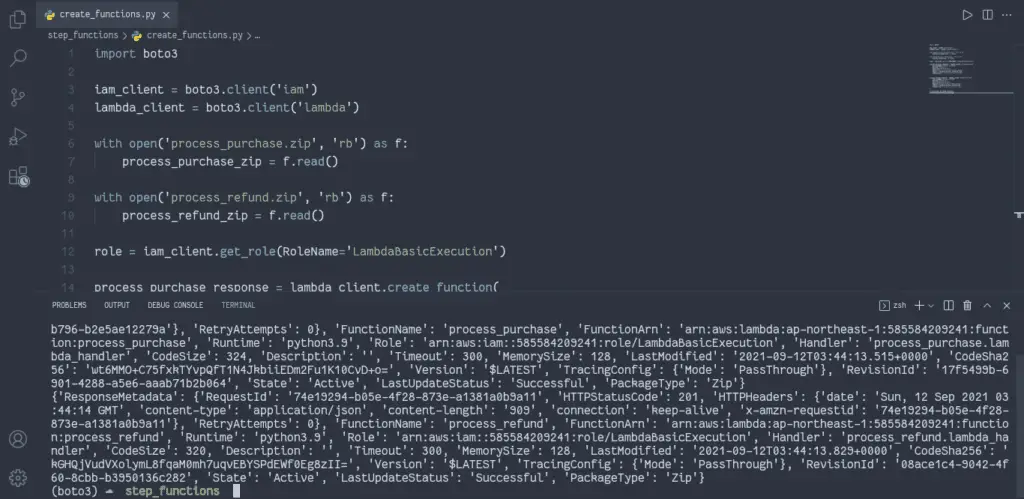
Step Functions workflow execution IAM role
Now, let’s grant Step Functions workflow (state machine) permissions to trigger Lambda functions:
import boto3
import json
iam = boto3.client('iam')
role_policy = {
"Version": "2012-10-17",
"Statement": [
{
"Sid": "",
"Effect": "Allow",
"Principal": {
"Service": "states.amazonaws.com"
},
"Action": "sts:AssumeRole"
}
]
}
response = iam.create_role(
RoleName='StepFunctionLambdaBasicExecution',
AssumeRolePolicyDocument=json.dumps(role_policy),
)
attach_policy_response = iam.attach_role_policy(
RoleName='StepFunctionLambdaBasicExecution',
PolicyArn='arn:aws:iam::aws:policy/service-role/AWSLambdaRole'
)
print(response)
print(attach_policy_response)Here’s an execution output:
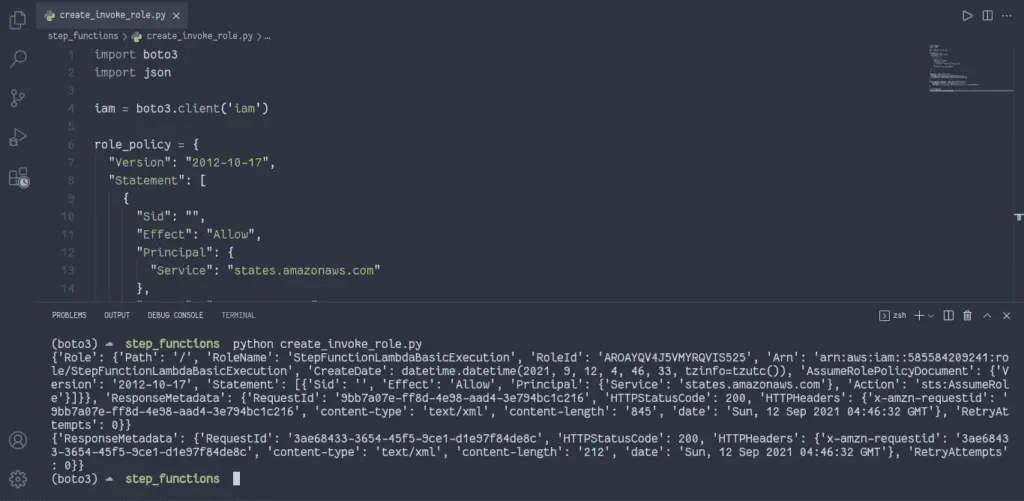
Step Functions workflow deployment
Finally, we can deploy the Step Functions workflow:
import boto3
import json
sfn_client = boto3.client('stepfunctions')
lambda_client = boto3.client('lambda')
iam_client = boto3.client('iam')
process_purchase_lambda = lambda_client.get_function(
FunctionName='process_purchase'
)
process_refund_lambda = lambda_client.get_function(
FunctionName='process_refund'
)
role = iam_client.get_role(RoleName='LambdaBasicExecution')
process_purchase_arn = process_purchase_lambda['Configuration']['FunctionArn']
process_refund_arn = process_refund_lambda['Configuration']['FunctionArn']
asl_definition = {
'Comment': 'Transaction Processor State Machine',
'StartAt': 'ProcessTransaction',
'States': {
'ProcessTransaction': {
'Type': 'Choice',
'Choices': [
{
'Variable': '$.TransactionType',
'StringEquals': 'PURCHASE',
'Next': 'ProcessPurchase'
},
{
'Variable': '$.TransactionType',
'StringEquals': 'REFUND',
'Next': 'ProcessRefund'
}
]
},
'ProcessPurchase': {
'Type': 'Task',
'Resource': process_purchase_arn,
'End': True
},
'ProcessRefund': {
'Type': 'Task',
'Resource': process_refund_arn,
'End': True
}
}
}
response = sfn_client.create_state_machine(
name='ProcessTransactionStateMachine',
definition=json.dumps(asl_definition),
roleArn=role['Role']['Arn']
)
print(response)Here’s an execution output:
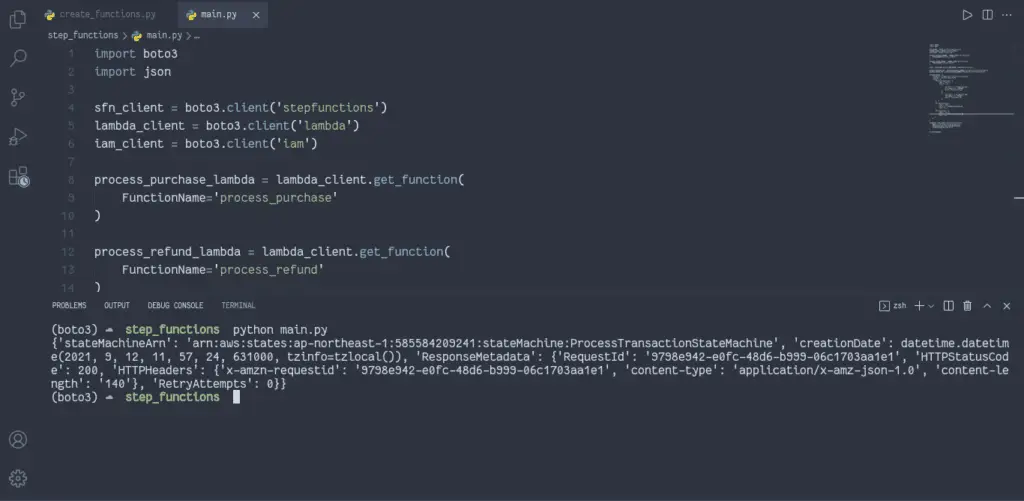
Describe Step Functions workflow
To describe the Step Functions workflow, you need to use the describe_state_machine() method for the Boto3 SFN client.
import boto3
sfn_client = boto3.client('stepfunctions')
state_machine_arn = 'arn:aws:states:ap-northeast-1:585584209241:stateMachine:ProcessTransactionStateMachine'
response = sfn_client.describe_state_machine(
stateMachineArn=state_machine_arn
)
print(response)Here’s an execution output:
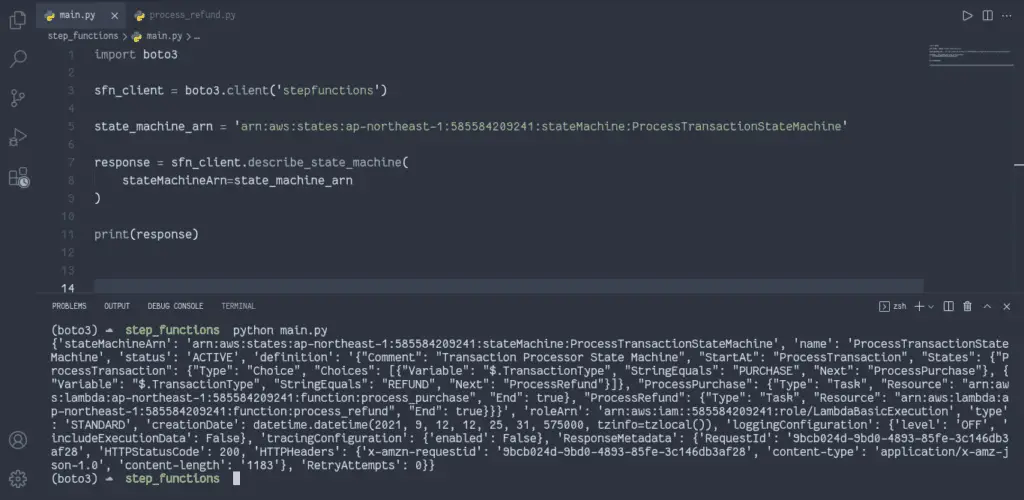
Execute Step Functions workflow
To execute the Step Functions workflow, you must use the start_execution() method for the Boto3 SFN client.
In our demo example, the Step Functions workflow expects the following JSON data structure as an input:
{
TransactionType: "PURCHASE"
}Depending on the TransactionType, State Machine will invoke different Lambda functions.
Expected transaction types are:
- PURCHASE
- REFUND
Note: if there’s no input data for the Step Function workflow, you still have to provide an empty JSON structure, for example: "{}".
import boto3
import json
sfn_client = boto3.client('stepfunctions')
state_machine_arn = 'arn:aws:states:ap-northeast-1:585584209241:stateMachine:ProcessTransactionStateMachine'
response = sfn_client.start_execution(
stateMachineArn=state_machine_arn,
name='test1',
input=json.dumps({ 'TransactionType': 'PURCHASE' })
)
print(response)Here’s an execution output:
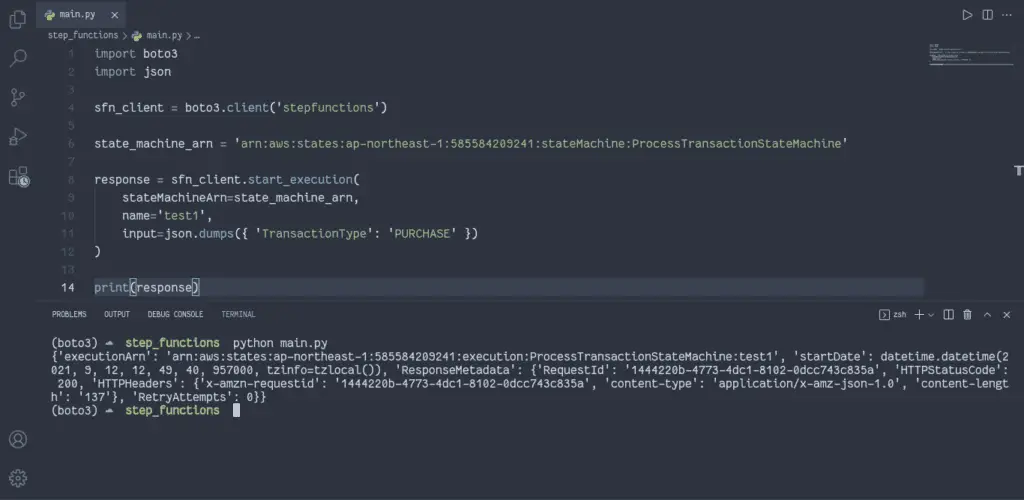
Based on the provided input, you’ll see different execution results:

List Step Functions workflows
To list Step Functions workflows, you must use the list_state_machines() method for the Boto3 SFN client.
import boto3
import json
sfn_client = boto3.client('stepfunctions')
response = sfn_client.list_state_machines()
print(response)Here’s an execution output:
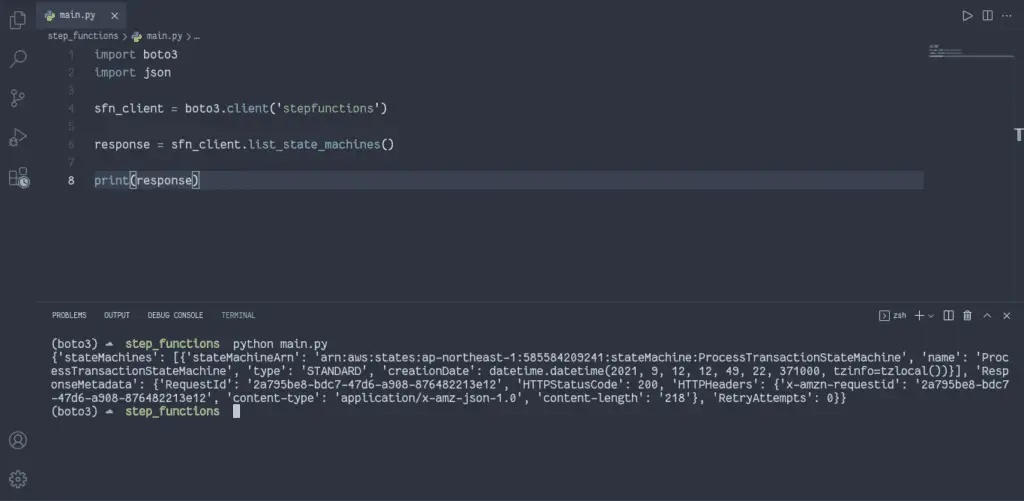
Delete Step Functions Workflow
To delete Step Functions workflows, you need to use the delete_state_machine() method for the Boto3 SFN client.
import boto3
sfn_client = boto3.client('stepfunctions')
state_machine_arn = 'arn:aws:states:ap-northeast-1:585584209241:stateMachine:ProcessTransactionStateMachine'
response = sfn_client.delete_state_machine(
stateMachineArn=state_machine_arn
)
print(response)Here’s an execution output:
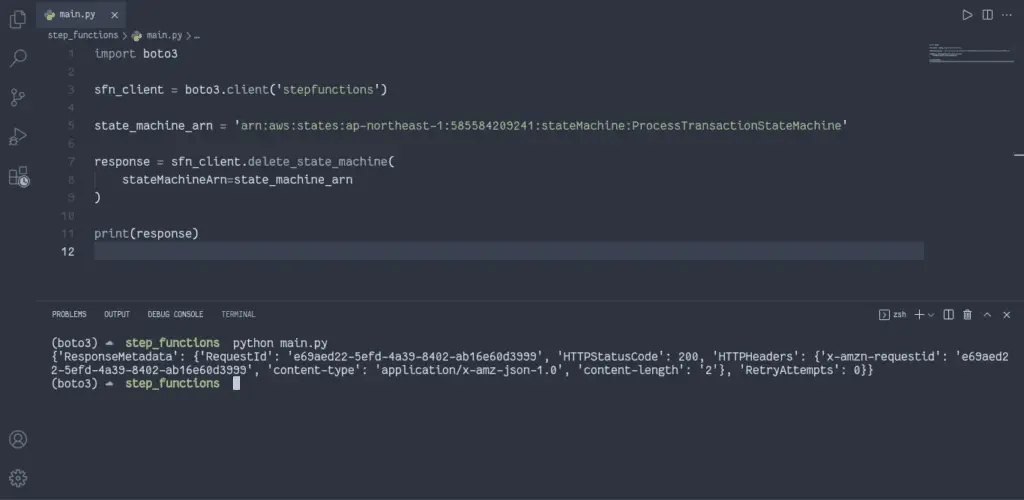
Summary
In this article, we’ve covered how to manage AWS Step Functions using the Python Boto3 library. We’ve created a demo Step Function workflow that invokes different Lambda functions depending on the provided input.
